Ragi Dosa Recipe | Nachni Dosa
When it comes to healthy food, the ancient grain ragi or finger millet is one of the most nutritious food stuffs that you can have. So, in this post, I have shared one of my personal favorite Ragi Recipes too, the Ragi Dosa. This is nothing but a hearty variation of dosa or crepes that are made with ragi flour. Apart from this recipe too, there are many ways these Finger Millet Crepes can be made. I am sharing a healthy fermented version of ragi dosa reicpe that is also gluten free.
About Fermented Ragi Dosa
The vegan fermented Ragi Dosa recipe is made with a fermented dosa batter, like the regular classic Dosa. This one thus, has a longer process, since there are different batters that need to be ground and then mixed to get the final batter.
It is also takes time, as the final batter needs to be kept for fermentation for best dosas. But is a better tasting and more healthier version than the Instant dosa made with ragi flour.
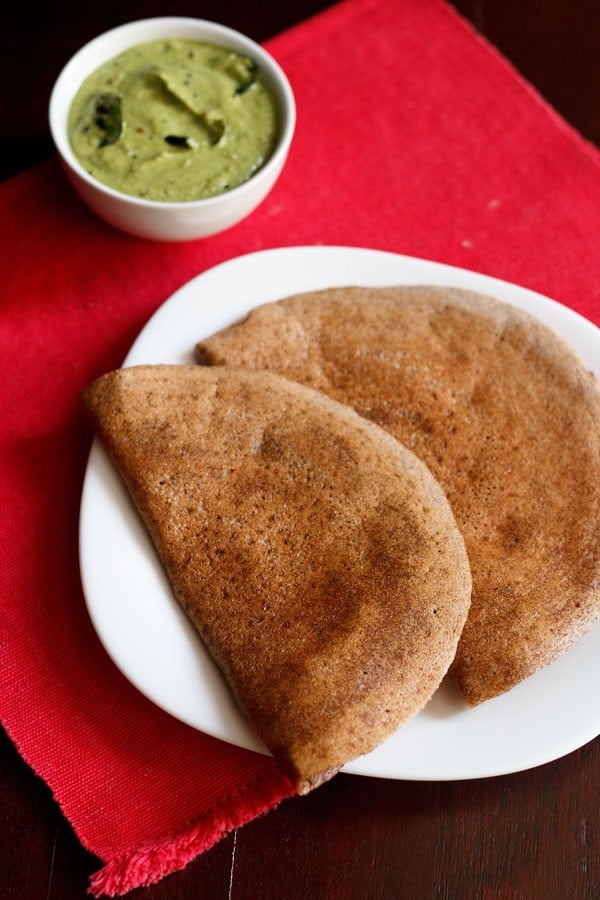
Ragi or finger millet is a healthy seed and I do include them wherever I can. I make the Ragi Dosa with ragi flour and not the ragi seeds. However, you can make this dosa by soaking and grinding finger millet seeds as well.
With the Fermented Ragi Dosa batter, you can even make yummy and hearty idli. I have also shared the recipe of Ragi Idli made with this batter. These dosas are both crisp and soft, and the idlis too are also soft and fluffy. So, you can make both idli and dosa with this batter.
Like regular dosa, this Fermented Ragi Dosa also pairs well with coconut chutney, coconut-garlic chutney and sambar or even idli-dosa podi (dry chutney).
How to make Fermented Ragi Dosa
Soak Rice and Lentils
1. Take 1 cup idli rice or parboiled rice (ukda chawal, sela chawal) in a bowl.
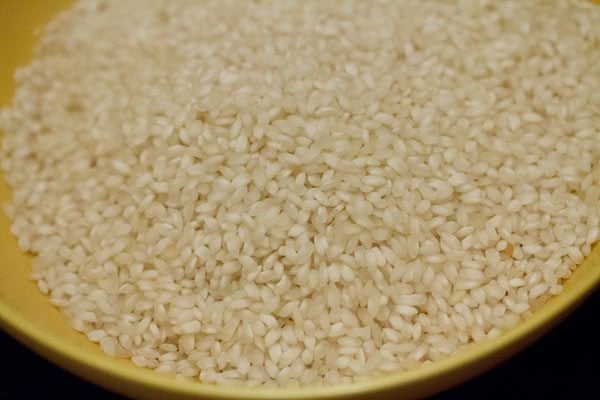
2. Rinse the rice a couple of times with clean water. Add 1 to 1.5 cups water and keep aside.
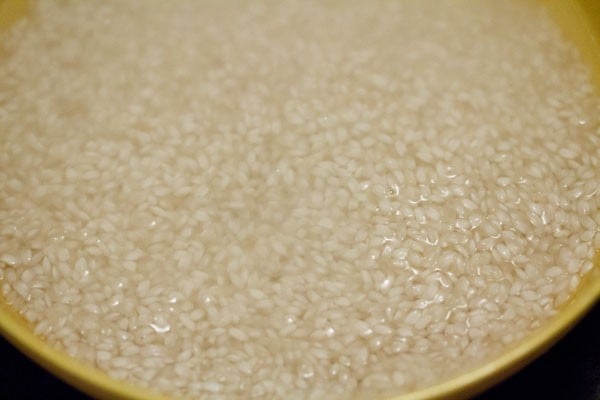
3. Rinse ¼ cup thick poha (flattened rice) once or twice and add to the rice bowl. Mix very well. Cover and keep aside to soak for 4 to 5 hours.
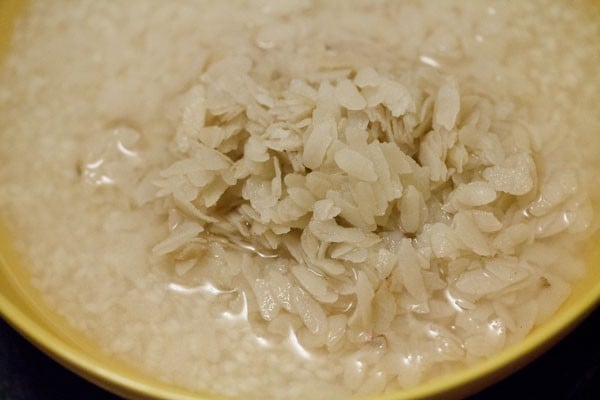
4. In another bowl, take ½ cup urad dal and ¼ teaspoon fenugreek seeds (methi).
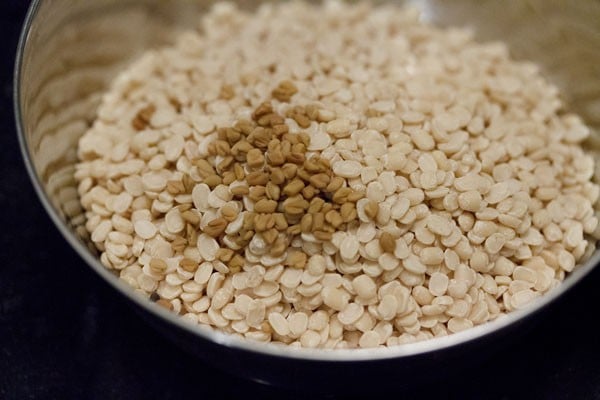
5. Rinse both for a couple of times. Then, soak both the urad dal with the fenugreek seeds in 1 cup water for 4 to 5 hours.
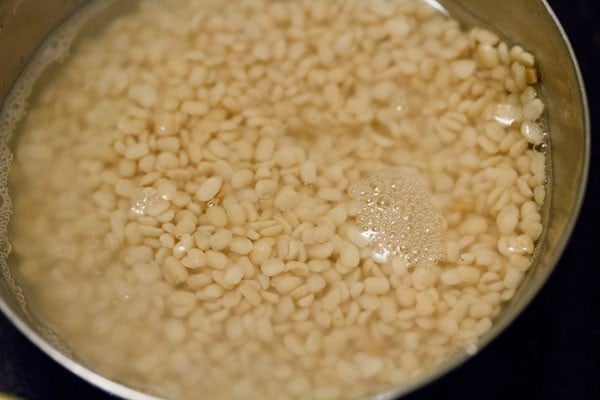
Make Urad Lentil Batter
6. After 4 to 5 hours, drain the urad dal and add in a mixer-grinder jar. Also, add water in parts.
Initially, I added ¼ cup water and blend or ground for some seconds. Then, I added ¼ cup water and continued to blend.
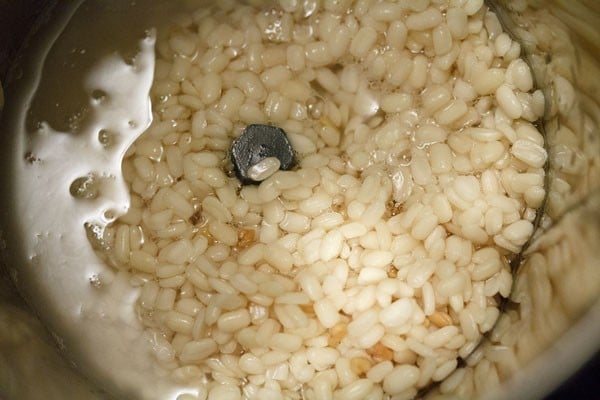
7. Grind the urad dal and fenugreek seeds until you get a smooth and fluffy batter. While grinding, add water in parts.
I added a total of ½ cup water for grinding urad dal. Once the batter is ground well, then pour the urad dal batter in a bowl or pan.
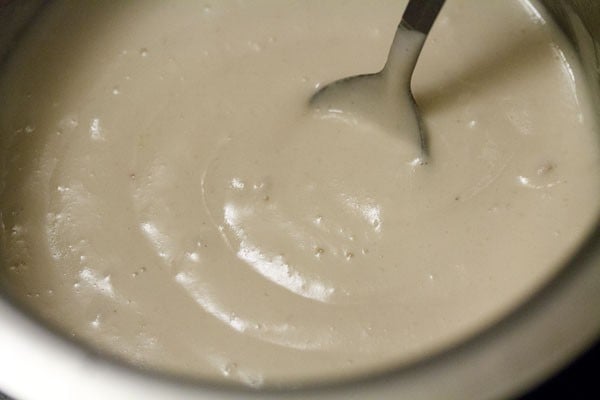
Make Rice Batter
8. Next, drain the rice, poha and add them to the same mixer-grinder jar. Depending on your jar capacity, you can grind the rice in 2 to 3 batches.
For the first round, I used ½ cup water and for the next round, I added ¼ cup water. So overall, I added ¾ cup water for grinding rice.
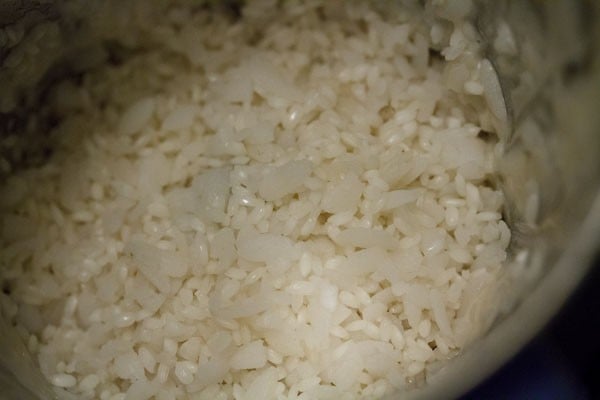
9. Grind the rice till smooth or a fine granular consistency in the batter is also fine.
While grinding, if the mixer-grinder becomes hot, then stop. Once the grinder cools down, then continue to grind.
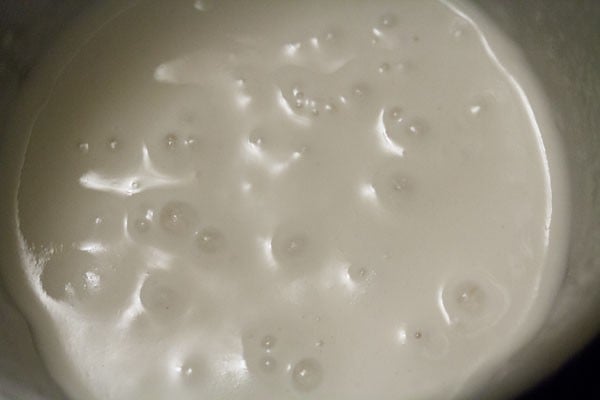
Make Ragi Dosa batter
10. Pour the rice batter in the same bowl containing the urad dal batter.
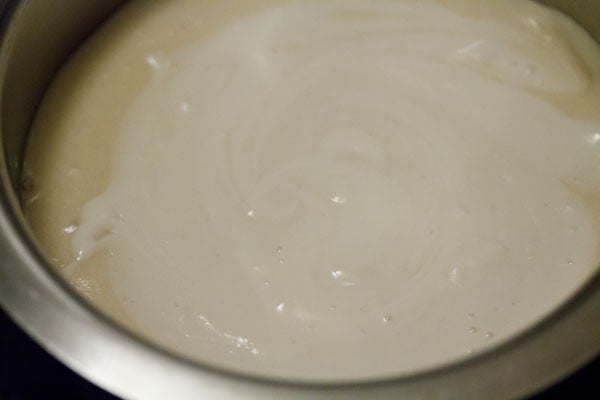
11. Mix both the batters very well.
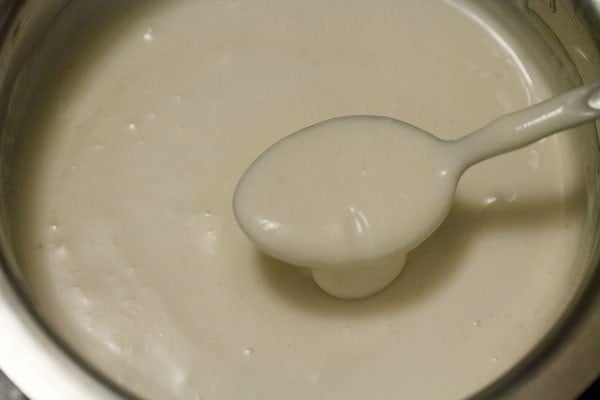
12. Now, add 1 cup ragi flour (nachni or finger millet flour).
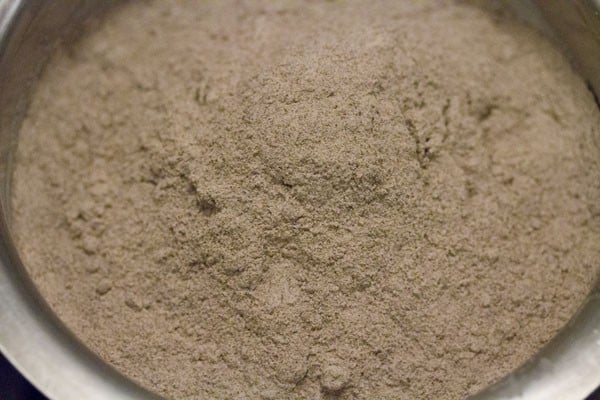
13. Then, add ½ cup water. You can adjust the quantity of water, depending on the consistency of the batter.
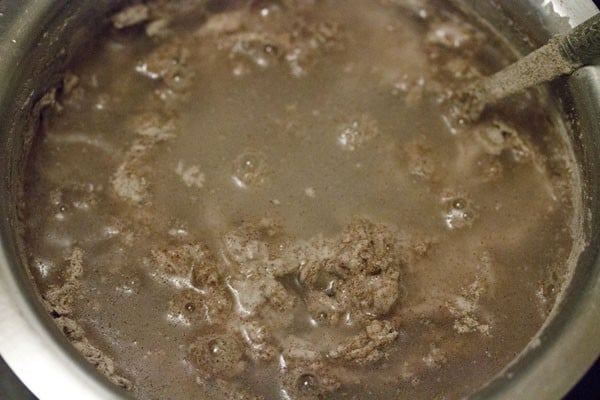
14. Mix very well with a wired whisk, spoon or with your hands. Break the lumps, if any. Mix to a smooth batter.
A bit of handwork is required while mixing the ragi flour with the dosa batter.
Alternatively, you can mix the ragi flour in ½ cup water in a separate bowl. Then, add this ragi batter to the rice and lentil batter. There would be no lump formation this way and also less strain while mixing.
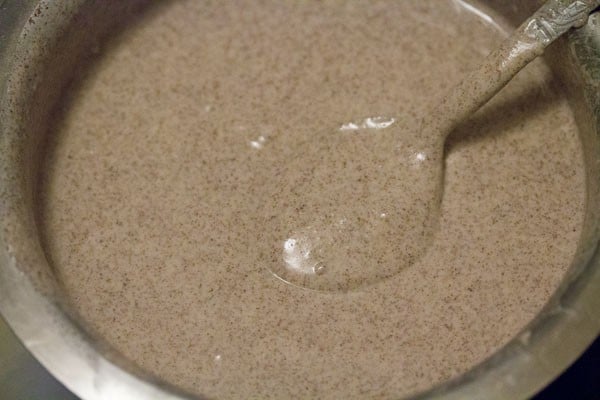
15. Cover the bowl or pan with a lid and let it ferment overnight, 8 to 9 hours or more depending on the temperature conditions in your city. The batter will increase in volume and double up.
Note that in a cool or cold climate the batter will take more time to ferment. To speed the fermentation process, keep the batter bowl in a warm place in your kitchen.
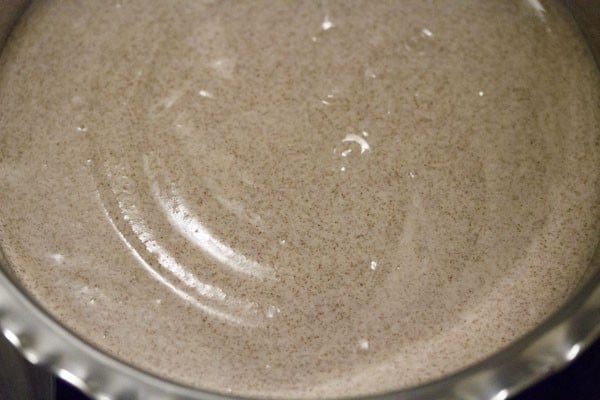
16. The dosa batter after fermentation on the next day.
If the batter does not increase in volume, then add 1.5 to 2 tablespoons of curd ot yogurt and ¼ teaspoon baking soda in the batter.
Mix very well. Let the batter rest for 30 minutes and then proceed to make dosa or idli.
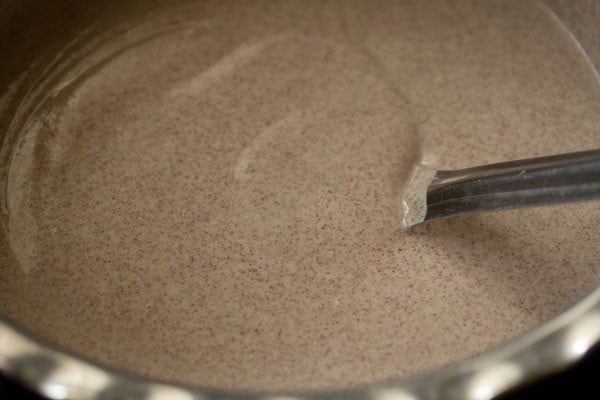
17. Add salt and mix very well. I added salt the next day, due to it being a cold season here. In a warmer climate, add salt before you keep the batter for fermentation.
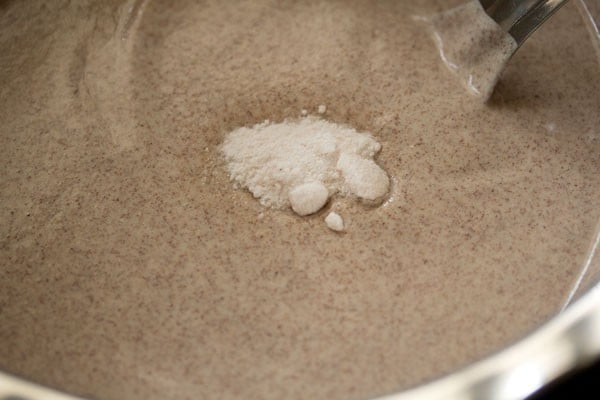
Cook Ragi Dosa
18. Heat an iron skillet/tawa or a non-stick pan. Dip half of an onion in oil and smear the oil on the iron tawa or griddle. If using non-stick pan, then don’t smear oil.
Use a well seasoned pan so that the dosa does not stick on to it.
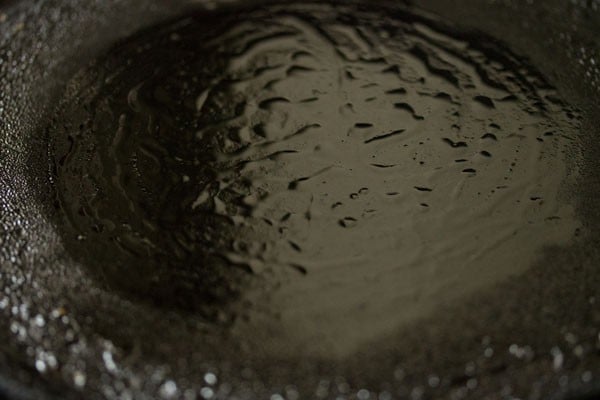
19. Pour a ladle of the batter and quickly spread the batter with the help of ladle in a circular motion.
If the batter is too thick for you to spread, add a few tablespoons of the water in the batter to change the consistency. Mix well and make dosa.
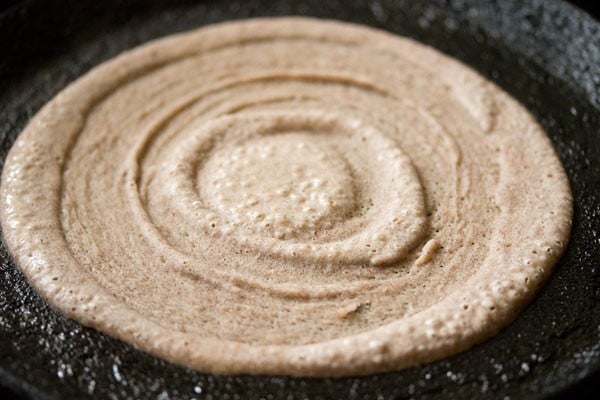
20. Let one side cook. Drizzle ½ to 1 teaspoon oil on the top and sides.
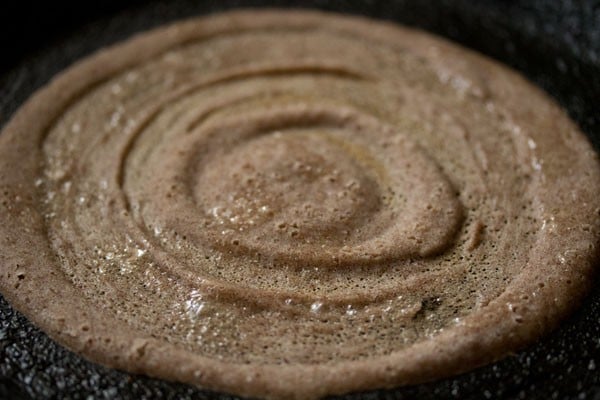
21. Flip and cook the other side of dosa till crisp and browned. Instead of cooking the dosa on both sides, you can just cook one side.
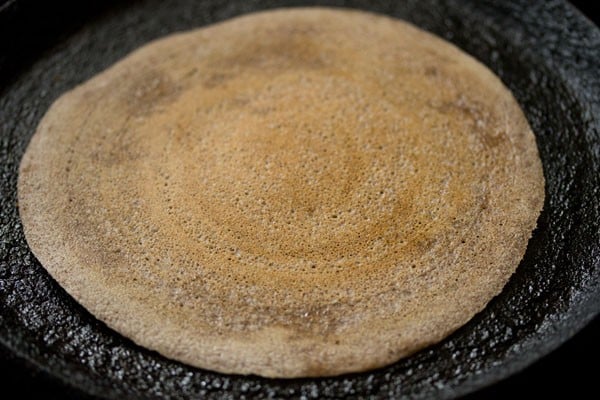
22. When both the sides are cooked and crisp, remove the dosa. Make the dosa in batches using up the remaining batter.
Keep any leftover in the fridge and use it within 2 to 3 days to make ragi dosa, or ragi Uttapam or ragi Paniyaram.
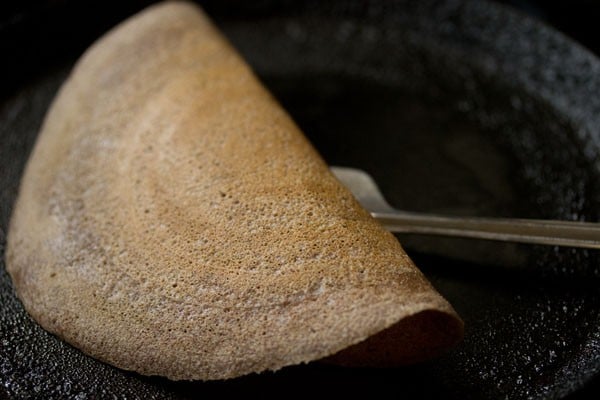
23. Serve this healthy fermented Ragi Dosa hot or warm. Any leftover batter can be refrigerated for a couple of days.
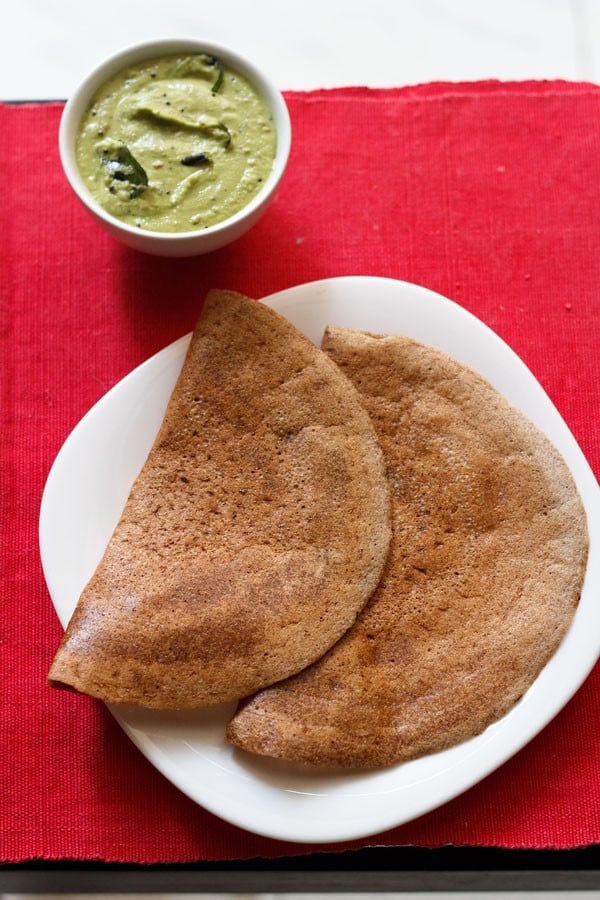
What is Ragi
Ragi, also known as finger millet or red millet, is an ancient grain that first originated in South Africa and later came to India. In India, Karnataka is one of the top producers of ragi. In rural areas of South Karnataka, ragi is consumed as a staple food.
These are tiny reddish seeds of the Eleusine Coracana plant. Just like this Ragi Dosa, mane other dishes are made using this grain, especially in the cuisines of Maharashtra and Karnataka. In Maharashtra, finger millet or ragi is also called as nachni. It is also known as mandua in Hindi, kezhvargu in Tamil and ragulu in Telugu.
In India, ragi dishes are commonly fed to infants, lactating mothers and people recovering from illnesses. As ragi is easily digestible and very nutritious.
Culinary Uses of Ragi
In India, ragi is used to make the Ragi Dosa along with various other dishes like flatbread (rotti), idli, vermicelli, pudding, porridge, sweets, cookies, cakes and even breads.
There is a special dish of ragi balls known as Ragi Mudde, which is a speciality from the cuisine of Karnataka. Nachni Ladoo, Ragi Rotti (bhakri and other flatbreads) and ragi papad are some popular ragi recipes from Maharashtrian cuisine.
Just like I love this Ragi Dosa, I also love the Ragi Porridge (also known as ragi malt) made with milk or water and jaggery. This is even a great food option for infants, kids and people recovering from illnesses.
Expert Tips
- Batter: You can also mix the ragi flour in ½ cup water (preferably warm) in a separate bowl. Then, add this ragi batter to dosa batter. There would be no lump formation this way and also less strain while mixing.
- Rice and Lentils: Easily swap the parboiled rice or idli recipe with any short-grained or medium-grained Indian variety of rice – parmal, sona masuri, ponni, kolam etc. You could also use idli rava. Soak about 1 cup of idli rava in water for 4 hours. Drain all the water very well from the idli rava and later grind it. Preferably use unpolished hulled urad dal – they can be whole or split.
- Fermentation: The time taken for the batter to ferment will depend on the temperature and weather conditions of your city. If you have colder climate, add salt after the batter is fermented. If you are in hot climate, add salt before you keep the batter for fermentation.
- If batter doesn’t ferment well: If the batter doesn’t increase in volume after fermentation, then just add about ¼ teaspoon baking soda, mix well and process to make dosa or idli. Alternatively opt to keep the batter for some more time for it to ferment well.
- Quality: Make sure to use good quality ingredients which are in their shelf life. Ragi flour gets rancid quickly and can get an off smell and a bitter taste. Use ragi flour that is within its shelf life. Do a taste test of the ragi flour and it should not taste bitter.
Step by Step Photo Guide Above
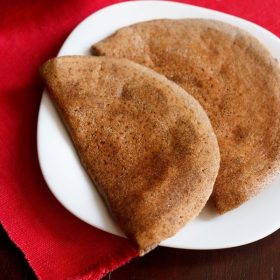
Ragi Dosa Recipe (Nachni Dosa)
Ingredients
- 1 cup idli rice or parboiled rice – 200 grams
- ½ cup urad dal (husked black gram) – 100 to 120 grams
- ¼ cup poha (flattened rice or parched rice)
- 1 cup ragi flour (nachni or finger millet flour) – 120 grams
- ¼ teaspoon fenugreek seeds (methi seeds)
- ½ cup water – for grinding urad dal or add as required
- ¾ cup water – for grinding rice or add as required
- ⅓ to ½ cup water – to be added later whiling mixing ragi flour
- 1 teaspoon rock salt (edible and food grade) – food grade and edible (sendha namak) or sea salt – add as required
- oil – as required for making ragi dosa
Instructions
Soaking rice and lentils
- In a bowl, rinse both the rice and poha. Then soak the rice with poha for 3 to 4 hours.
- In another bowl, rinse and soak the urad dal with the fenugreek seeds for 3 to 4 hours.
Making batter
- Drain the rice and poha of all the water. Then in a wet grinder, first grind the rice and poha, adding about ¾ cup water to a fine and smooth consistency. A fine granular consistency is also fine.
- Pour the rice batter in a deep bowl. Remove the batter clinging at the sides with a spatula and add in the bowl.
- Drain the urad dal. Then in the same grinder grind the urad dal and fenugreek seeds till you get a smooth and fluffy batter. Add ½ cup water in parts while grinding the urad dal.
- Pour the urad dal batter in the same deep bowl. Mix well.
- Add the ragi flour and ⅓ to ½ cup water. Again mix very well and thoroughly. There should be no lumps in the batter.
- Stir in salt. Close the bowl with a lid. Not airtight but just kept over it.
- Keep the ragi dosa batter in a warm place for 8 to 9 hours or more till the batter doubles up and is well fermented.
- If the batter does not increase in volume, then add 1.5 to 2 tablespoons of yogurt and ¼ teaspoon of baking soda in the batter. Stir and let it sit for some 30 minutes more and then proceed making with the dosa or idli.
Cooking ragi dosa
- Heat a cast iron skillet or tawa or a nonstick pan. Dip half of an onion in oil and smear the oil on the iron tava or griddle. If using non stick pan, then don't smear oil.
- Pour a ladle of the batter and quickly spread it with the help of ladle in a circular motion.
- Let the one side cook. Drizzle with ½ to 1 teaspoon oil on the top and sides.
- Flip and cook the other side of dosa till crisp and browned.
- Instead of cooking the ragi dosa on both sides, you can just cook one side.
- For cooking only on once side, after spreading the dosa batter on the hot tava, sprinkle oil on sides and top.
- Cover the dosa with a lid and cook till the base gets golden and the top is also cooked.
- Using the batter, make ragi dosa in batches this way. Regulate the stovetop heat as needed when making the dosa.
- Remove and serve the ragi dosa hot with coconut chutney and vegetable sambar.
Notes
- Ensure to mix the ragi flour very well with the rice and lentil batter. You can choose to mix the ragi flour first in ½ cup water in a separate bowl. Then, add this ragi batter to the rice and lentil batter. There would be no lump formation this way and also less strain on the hands while mixing.
- Keep in mind that in a cool or cold climate, the batter will take more time to ferment.
- Store any leftover batter in the fridge for 2 to 3 days.
- This recipe can be easily halved or doubled.
Nutrition
This Ragi Dosa recipe from the archives first published in May 2011 has been updated and republished on February 2023.

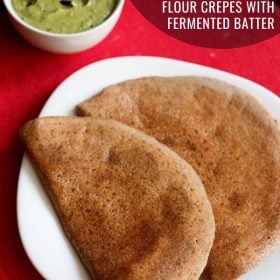
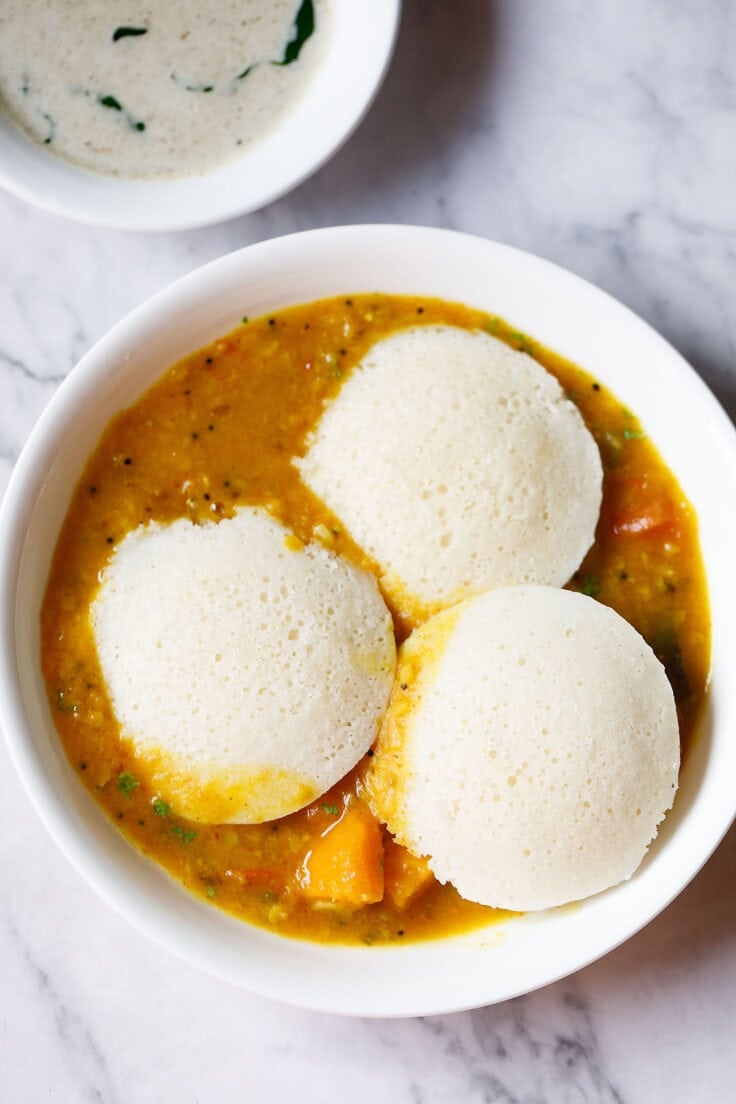
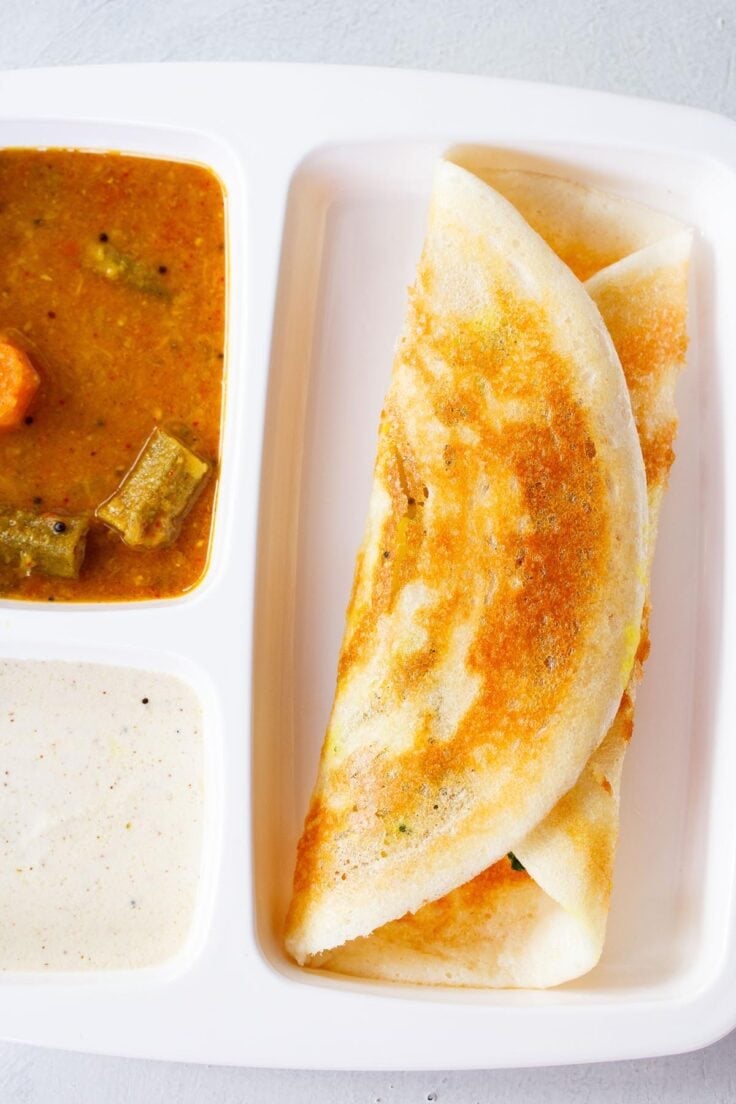
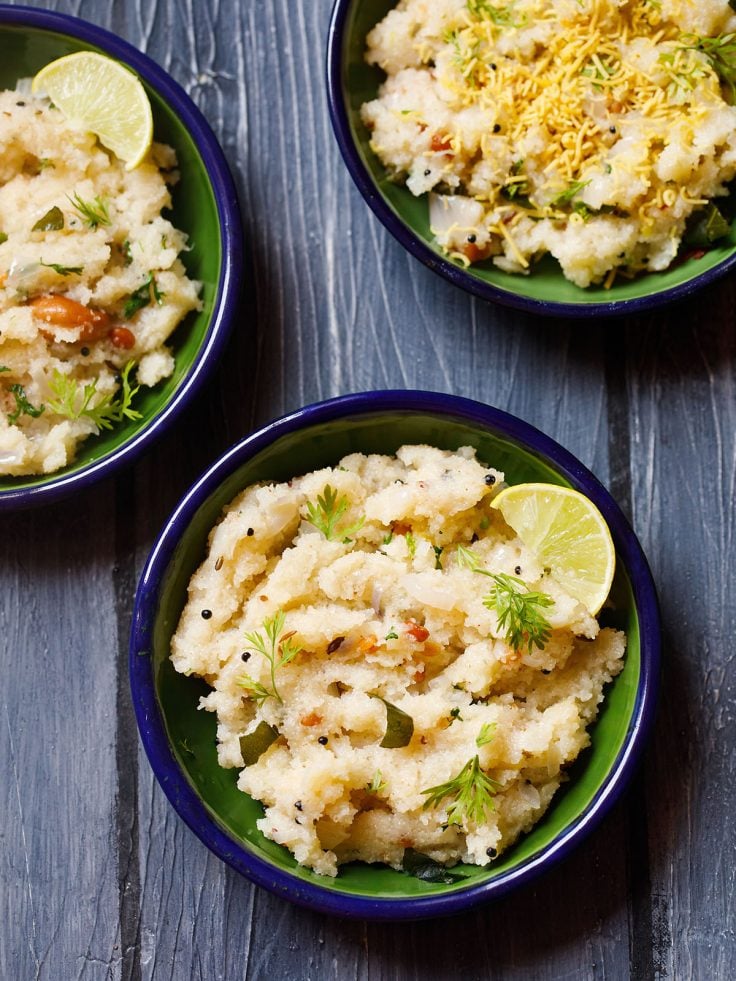
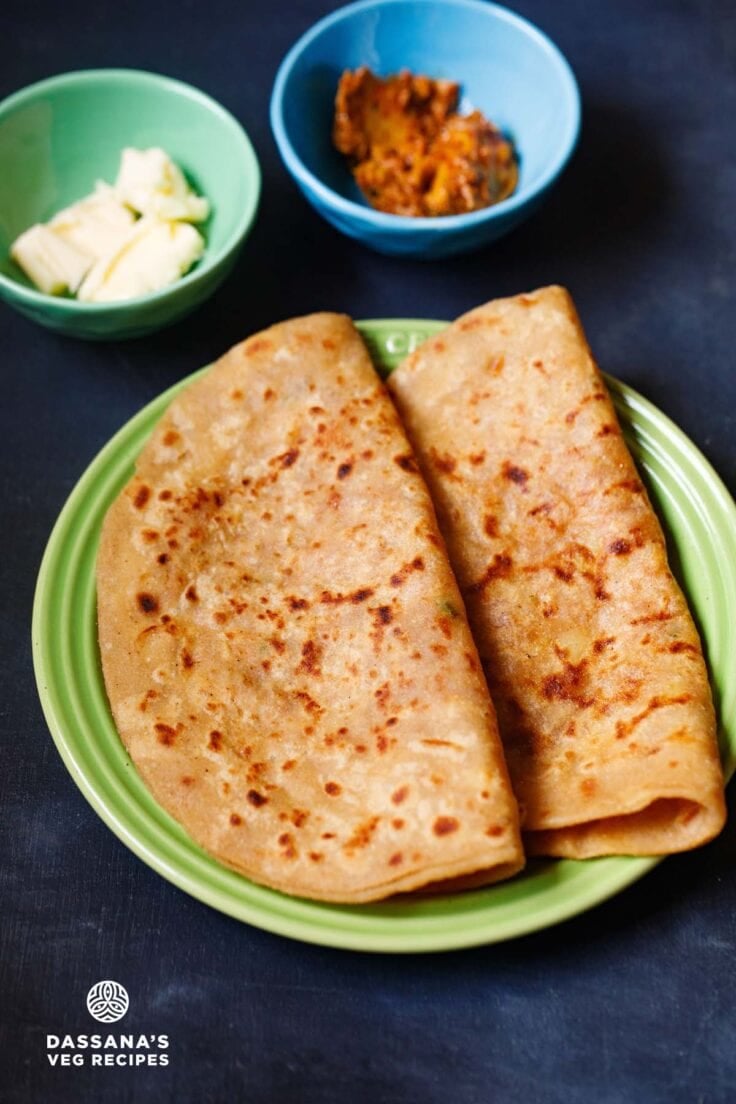
Since the day I tried this Ragi Dosa at home, its become a favourite of everyone, including my kids. Thank you Dassana for this fool-proof recipe.
Thank you so much for your lovely feedback. Glad to know the ragi dosa was liked by everyone, especially the kids!
The dosa turned out amazing each time Dassana. Thank you for the recipe!
Hi Ritu, happy to hear that. I am really glad the ragi dosa turned out well for you each time. Thank you for trying the recipe and sharing your feedback.
Dosas turned out awesome yet again Dassana! Thank you for the foolproof recipe. My daughter who is an extremely picky eater loved it ?
So happy to hear this, Ritu! It’s truly heartwarming when little ones enjoy homemade food. Thank you so much again for trying the recipe and sharing your lovely feedback.
I enjoy dishes prepared by your recipes. it really gets great every time !!
Thank you so much ☺️
Most welcome and thanks.
Each blogpost and recipe you share and write is like a mini-research project. Rich in content and one of the few food bloggers/YouTubers whom I trust cent per cent. There is a lot of competition out there, and you were one of the first few to begin this era. With content and perseverance like this, you will thrive and inspire many more like me. Thanks for all the effort that goes into your cooking and craft.
Thank you so much for the lovely inspiring comment. I had the advantage of starting out early. Then it was a peaceful place to blog and share the recipes. Thanks again for the trust and for the inspiration.
amazing , quick, healthy and wholesome preparation.
Thank you.
today in dinner i tried ragi dosa from your recipes it is just awesome came out so good… everyone loved it
thanks for sharing this sweta. glad to know ragi dosa was liked by everyone.
It turned out well.thanks for sharing yummy receipe
welcome gautami
Hi Dassana ,made ragi dosas today for breakfast and it really turned out awesome. My husband just loved it.thanks for the simple yet great recipe.:)
nice to know swati. thanks for sharing this feedback on the ragi dosa recipe. happy cooking.
I bought a bag of black urad dal just for the kicks. I didn’t particularly like the ‘Mah ki daal’ that I tried making, but I do not wish to waste the gram either. D’you think I could use that in the dosa batter instead?
And on another note , many thanks for building this website. don’t know what I’d do without you!
you can use black urad dal. but here after soaking the lentils, you have to remove the husks from them, before you grind them. just rub them between your palms and the skins will be peel off. but this takes time and needs patience. i have posted many dosa recipes. so you can make anyone of them. also you make medu vadas or pakoras. this is made from only urad dal batter. the recipes are posted on the website.
and thanks a lot 🙂
It came out awesome. My husband & me loved it. Will definitely make it more frequently 🙂
Thanks for the recipe
welcome miral
Hi Dassana,
I have tried so many recipes of yours and all turned out excellent. The recipes are not just tasty, yummy but its very healthy too. And the ingredients u use in d recipes are easily available and 90% of them will b ready at home anytime.
I have a question for the above recipe ‘Ragi Dosa’. Can I directly put Ragi (grains) instead of Ragi flour and if yes what is the procedure?. Thanks in advance and thanks for all the recipes.
you have to soak the grains overnight for 8 to 9 hours. they are hard grains and so need good amount of soaking. also you need a good grinder to grind the grains. then just drain and add them to the grinder. add some water and grind. you can soak up to ¾ cup whole ragi grains.
Awesome recipes quick, easy & healthy recipes. …Thank you….
welcome vani
nice
can i avoid rice for ragi dosa
no. you will need to add some rice.
Dear Dassana,
Thank you for posting such tasty and healthy recipes. This site has given me lot of good recipe ideas.
I have a query about the above ragi dosa recipe. How long does this batter stay in the fridge?
Thank you,
Neha
thanks neha. stays good for 1 to 2 days.
Hi Dassana, I simply love your food blog. Since we like trying different options, especially for breakfast, I end up using your recipes almost every day. This ragi dosa turned out soft and crisp too! I especially admire your ‘back to roots’ lifestyle. That’s the main reason I guess, that I refer to your recipes. 🙂
I use I have noticed that you use a cast iron tawa/ kadhai for cooking… I was looking at some tawas, but found the flat dosa tawas cumbersome because they are heavy and have a metal handle. The chapatti tawas were (very slightly) concave, although they were lighter and had a wooden handle. But the salesgirl advised me against using it for dosas… could you help me out here?
thanks preena for the positive feedback on ragi dosa and other recipes. the flat tawa that you see in the pics is iron tawa. mostly iron tawas are heavy so can’t help it. but you can make good dosas on them. don’t make dosas on concave tawa. the sales girl was right. concave tawa are best use for making roti/chappati or for sauteing or frying vegetables.
Ok let me try first
I’ve always wanted to make ragi dosas and so want to give this recipe a try. However, it’s hot out here and I would prefer to make idlis if possible.
I have soaked the urad and rice to grind tonight and use tomorrow morning. In point no 8 above you say “let it sit for some 30 minutes more and then proceed making with the dosas or idlis.” However, you don’t get into details about how to use it for idlis. I am assuming the same batter can be used for idlis?
Thanks
Gitanjali
the same batter can be used for idlis. point no 8 is only to be done if the batter does not double or triple. if the batter ferments well, then no need to implement point no 8. i jave not mentioned details as the post was specifically meant for making ragi dosa. yet since i have made idlis with the same batter, thats why i mentioned in the post itself.
Thanks a lot. It’s hot, so I expect it to rise well, and if it does I’ll make idlis.
welcome gitanjali
Can ragi dosa be made with idli rava instead of parboiled rice? If not, can regular rice be used?
Parul, yes you can make with idli rava. soak the idli rava for 3-4 hours. drain and then grind.
I prepared ragi dosa according to your recipe.. turned out very good. Thanks for posting this recipe, my guests liked this a lot.
welcome vijayalakshmi and thanks for the positive feedback on dosa.